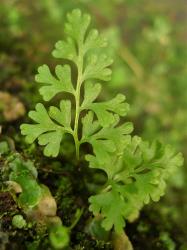Terrestrial ferns; sporophytes annual, growing from a perennial and tuberous prothallus. Rhizomes erect, rudimentary, bearing multicellular hairs. Fertile and sterile fronds dimorphic. Stipes pale brown to red-brown, glossy. Sterile laminae irregularly flabellate. Fertile laminae 1–3-pinnate, herbaceous, glabrous. Pinnae and ultimate lamina segments not articulated to rachis and costae. Veins free. Sori extending along the veins, exindusiate; paraphyses absent. Spores trilete, lacking chlorophyll; perispores verrucate to tuberculate with prominent ridges parallel to the equatorial flange.
A genus of two to five species included in subfamily Pteridoideae, along with Pteris (Nakazato & Gastony 2003; Zhang et al. 2015; PPG 1 2016).
Anogramma, as traditionally interpreted, has been shown to be polyphyletic (Nakazato & Gastony 2003), with one species more closely related to Jamesonia, others to Pityrogramma, and two previously recognised species nested within Anogramma leptophylla. Indeed, only the widespread A. leptophylla and the South American A. lorentzii remain within the Anogramma clade, along with the European Cosentinia vellea, which can be treated as a monotypic genus or included within Anogramma.
In New Zealand, Anogramma can be recognised by its small, delicate fronds with exindusiate sori extending along the veins. It also has distinctive trilete spores with double or triple, broad equatorial ridges, and verrucate to tuberculate faces (Large & Braggins 1991).
Anogramma leptophylla is subcosmopolitan, occurring in Central and South America, southern Europe, Africa, India, southern Asia, and Australasia. A. lorentzii is restricted to South America. Other species previously included in Anogramma either belong elsewhere or are synonymous with A. leptophylla (Nakazato & Gastony 2003). One indigenous species in New Zealand.
| Category | Number |
|---|---|
| Indigenous (Non-endemic) | 1 |
| Total | 1 |
Base chromosome numbers of x = 26, 27 or 29 have been recorded in Anogramma (Lovis et al. 1993).




